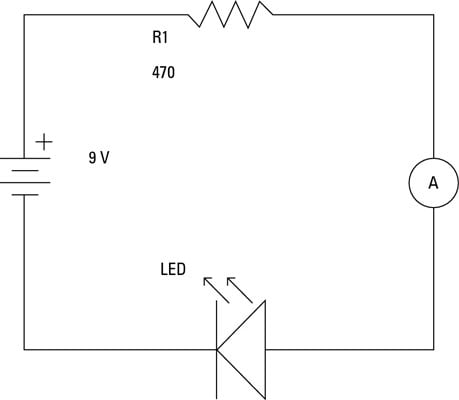Electric current is measured in amperes, but actually in most electronics work, you'll measure current in milliamps, or mA. To measure current, you must connect the two leads of the ammeter in the circuit so that the current flows through the ammeter. In other words, the ammeter must become a part of the circuit itself.
The only way to measure the current flowing through a simple circuit is to insert your ammeter into the circuit. Here, the ammeter is inserted into the circuit between the LED and the resistor.

Note that it doesn't matter where in this circuit you insert the ammeter. You'll get the same current reading whether you insert the ammeter between the LED and the resistor, between the resistor and the battery, or between the LED and the battery.
To measure the current in the LED circuit, follow these steps:
Set your multimeter's range selector to a DC milliamp range of at least 20 mA.
This circuit uses direct current (DC), so you need to make sure the multimeter is set to a DC current range.
Remove the jumper wire that connects the two terminal strips.
The LED should go dark, as removing the jumper wire breaks the circuit.
Touch the black lead from the multimeter to the LED lead that connects to the terminal strip (not the bus strip).
Touch the red lead from the multimeter to the resistor lead that connects to the terminal strip (not the bus strip).
The LED should light up again, as the ammeter is now a part of the circuit, and current can flow.
Read the number on the multimeter display.
It should read between 12 and 13 mA. (The exact reading will depend on the exact resistance value of the resistor. Resistor values aren't exact, so even though you're using a 470 Ω resistor in this circuit, the actual resistance of the resistor may be anywhere from 420 to 520 Ω.
Congratulate yourself!
You have made your first official current measurement.
After a suitable celebration, replace the jumper wire you removed in Step 2.
If you forget to replace the jumper wire, you won’t be able to take other measurements successfully.
There are two places in this circuit that you should not connect the ammeter. First, don't connect the ammeter directly across the two battery terminals. This effectively shorts out the battery. It will get real hot, real fast. Second, don't connect one lead of the ammeter to the positive battery terminal and the other directly to the LED lead. That will bypass the resistor, which will probably blow out the LED.
If you want to experiment a little more, try measuring the current at other places in the circuit. For example, remove the battery snap connector from the battery, and then reconnect it so that just the negative battery terminal is connected. Then, touch the red meter lead to the positive battery terminal and the black lead to the lead of the resistor that's connected to the bus strip.
This measures the current by inserting the ammeter between the resistor and the battery. You should get the same value that you got when you measured between the LED and the resistor.
You can use a similar method to measure the current between the LED and the negative battery terminal. Again, the result should be the same.

